China Travel
Marble Floors, Gold Ceilings: This is China’s Most Luxurious Horse Stable
Lavish chandeliers and marble floors are perhaps not the first things that come to mind when thinking about horse stables. Despite some media writing that “the world’s most luxurious stable” is located in Dubai, this is the Heilan Equestrian Club in Jiangsu, China.
Published
8 years agoon
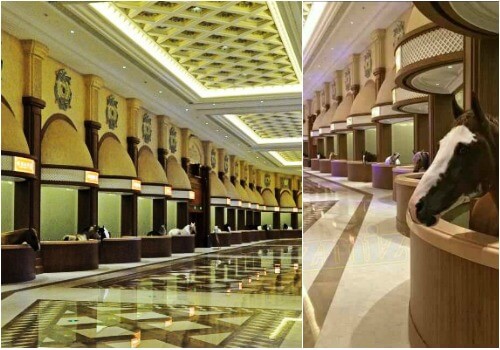
Lavish chandeliers and marble floors are perhaps not the first things that come to mind when thinking about horse stables. Despite some media writing that “the world’s most luxurious stable” is located in Dubai, this is the Heilan Equestrian Club in Jiangsu, China.
“Only in Dubai would you see a marble-floored horse stable”, a Redditor named Randvoo12 posted on Reddit on March 16. The post made it to the top trending posts on Reddit, but soon turned out not to be about Dubai at all. As one user (Leehomf) pointed out, the stables are actually located in Jiangsu, China.

Image via oldkids.cn/blog.
Netizen Leehomf, who has visited the stables, shared on Reddit that the equestrian club is owned by the founder of the Heilan group, “a multi-billion corporation based in Xinqiao, China. This man bought many breeds of horses from all over the world and put them in a lavishly constructed hall to show off his wealth.” The Redditor pointed out that despite all the glitter and glamour, “the place smelt just like a farm.”
Jiangsu’s Luxury Town
The Heilan Equestrian Club (飞马水城管理中心) in Xinqiao (Jiangyin) is to be part of a larger luxurious town (衣尚小镇) that will include an ecological tourism resort with a Venetian water park, a university campus, a cultural center and other projects – an initiative by the China Heilan Group.
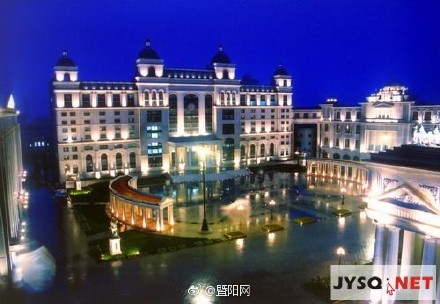
According to a local Jiangsu Weibo account (@暨阳网), the completion of the whole project will cost over 8 billion RMB (±1.1 billion US$) in the coming three years.
“Horse Culture Museum”
As also pointed out by the Pickle website, the pictures of the impressive marble stable are taken at the Heilan Equestrian Club’s so-called “Horse Culture Museum”, where equine-related art and fancy horses are displayed in an area that covers approximately 260,000 square meters.

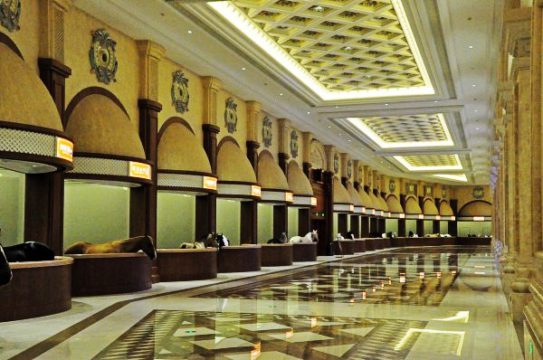
According to the official Heilan website, the horse center is located in the southern area of Xinqiao, and is China’s “first-ever comprehensive equestrian facility”, a place that offers equestrian training, performances, competition, and recreational services.
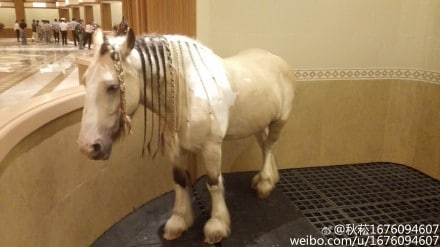
Some netizens (including @秋菘1676094607 and @共同的风景) also shared pictures of the Horse Center on Weibo.
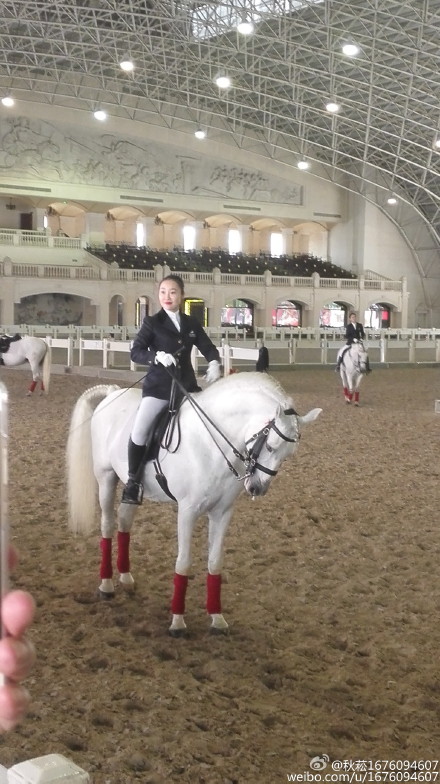
The Heilan Group bought more than 200 high-end horses from countries such as the Netherlands, Spain, and Germany for their equestrian center, which was formally established in 2009.
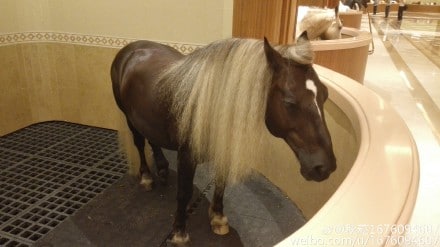
The center is also home to approximately 60 Chinese horses from Xinjiang, Beijing, and Inner Mongolia. According to China’s Baike wiki, there are 36 specialized equestrian trainers from various countries.
Stuffed Horses
In 2015, the Heilan Equestrian Club’s owner Zhou Jianping placed an order at a Dutch taxidermy company to have a total of 12 horses stuffed for his museum.
The owner of the Dutch taxidermy company, Maurice Bouten, told website Horses at the time: “They called me asking if I could stuff horses. They wanted a total of twelve. I first thought it was a joke, but the project really happened.”
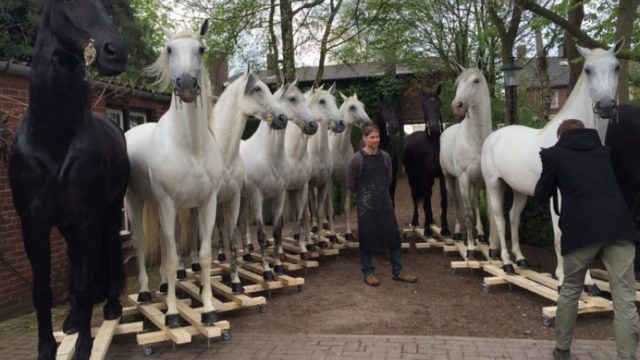
The Chinese director came up with four Frisian and eight Andalucian horses that were about to be slaughtered. It took Bouten approximately 150 hours per horse to finish the project (image by 1limburg.nl). The horses were then exported to China per airplane.
No, not Dubai!
Not just on Reddit, but also on Weibo, many netizens seem to think the marble-floored stables are located in Dubai. A post saying “look at these Dubai stables” attracted attention on Weibo today.
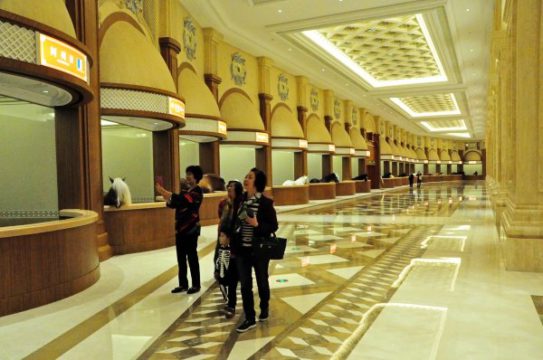
“I am from Jiangyin,” one netizen clarified: “And this is definitely the Heilan Horse Club!”
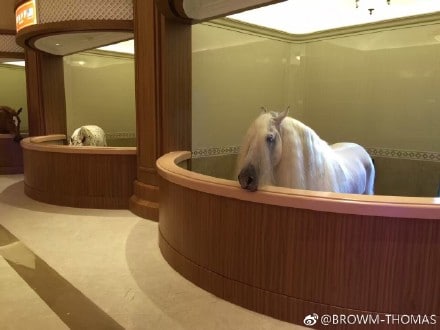
Besides the many people confirming that these photos most definitely were not taken in Dubai, there were also those who were critical in different ways: “People who really know about horses would never approve of this. This is not a proper environment for a horse!”
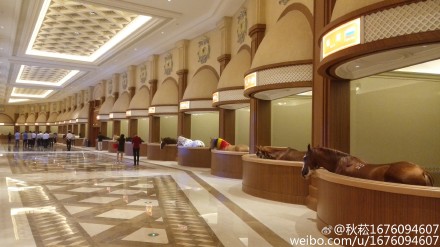
“This might all be glorious splendor to you, but it doesn’t mean anything to the horses” another Weibo user wrote: “They should be grazing the grassland.”
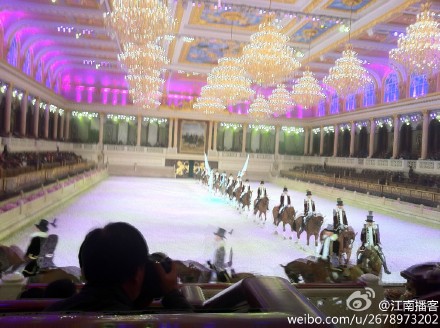
– By Manya Koetse
Follow @WhatsOnWeibo
[showad block=1]
Images in this post from Reddit, Weibo, oldkids.cn/blog, and www.1limburg.nl.
©2017 Whatsonweibo. All rights reserved. Do not reproduce our content without permission – you can contact us at info@whatsonweibo.com.
Manya is the founder and editor-in-chief of What's on Weibo, offering independent analysis of social trends, online media, and digital culture in China for over a decade. Subscribe to gain access to content, including the Weibo Watch newsletter, which provides deeper insights into the China trends that matter. More about Manya at manyakoetse.com or follow on X.
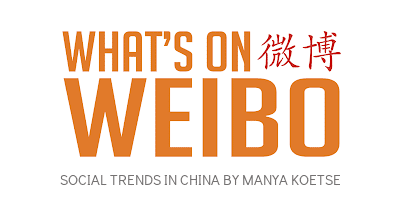
China Travel
Lured with “Free Trip”: 8 Taiwanese Tourists Trafficked to Myanmar Scam Centers
Published
1 week agoon
June 3, 2025
🔥 Quick Take: Trending in China
This is a brief update from our curated roundup of what’s trending in China this week. A version of this story also appears in the Weibo Watch newsletter. Subscribe to stay in the loop.
“Taiwan Tour Group Sold to Myanmar” is the headline that’s currently making its rounds on social media after Chinese media reported on June 3rd that a group of eight tourists from Taiwan became victims of telecom fraud-related human trafficking in Myanmar. They fell for a scam involving a so-called “free trip to Thailand.”
The group had been lured to Thailand by a scam ring that promised them, among other things, short-term high-paying jobs at a Thai casino. Once in Thailand, their passports were confiscated, and they were transported to Myanmar by an ethnic armed group.
Three women from the group managed to escape after they were reportedly deemed too old to participate in the cyberfraud operations — they didn’t even know how to use a smartphone — and were then forced to pay a ransom of around US$9715 each to be released.
The whereabouts and the fate of the five younger tourists, who were allegedly resold to other scam compounds, remain unknown.
The case quickly trended on Weibo (#台湾旅行团整团被卖到缅甸#), where an earlier incident involving Chinese actor Wang Xing (王兴) also became major news. In January this year, Wang was trafficked to a scam center in Myanmar after flying to Bangkok for what he believed was a movie casting call. He was then forced into cyberfraud training before being rescued by Thai police on January 7. His case drew global attention to the widespread human trafficking and forced labor happening in Myanmar’s scam compounds, where hundreds are held captive.
Despite the serious nature of the recent news, the fact that three ladies were saved from their predicament by not being tech-savvy enough also raised some eyebrows: “I never expected that not knowing how to use a smartphone could be such an advantage,” one top commenter wrote.
Others wondered: “Instead of scamming us, they’ve now moved on to Taiwanese?” Some commenters also remarked that “free” offers often come with hidden costs, writing: “If you see a product being offered for free to you, then perhaps it’s you that’s the product.”

Image on Weibo posted in response to the news: “If you see a product being offered for free to you, then perhaps it’s you that’s the product.”
In February 2025, Chinese President Xi Jinping met with Thai Prime Minister Paetongtarn Shinawatra to discuss strengthening bilateral security cooperation and pledged to intensify efforts to dismantle these scam networks.
Nevertheless, there are many Chinese social media commenters who say they’d rather avoid Thailand all together to avoid any risks. Others even take it a step further: “Just don’t go to Southeast Asia at all.”
By Manya Koetse
(follow on X, LinkedIn, or Instagram)
Spotted a mistake or want to add something? Please let us know in comments below or email us. First-time commenters, please be patient – we will have to manually approve your comment before it appears.
©2025 Whatsonweibo. All rights reserved. Do not reproduce our content without permission – you can contact us at info@whatsonweibo.com.
China Memes & Viral
The ‘Cycling to Kaifeng’ Trend: How It Started, How It’s Going
The Kaifeng cycling craze revealed more than just the adventurous spirit of Chinese students.
Published
7 months agoon
November 12, 2024
PREMIUM CONTENT
From city marketing to the spirit of China’s new generation, there are many themes behind the recent Zhengzhou trend of thousands of students cycling to Kaifeng overnight.
The term ‘yè qí‘ (夜骑), meaning “night ride,” has recently become a buzzword on Chinese social media. Large groups of students from various schools and universities in Zhengzhou, the capital of Henan province with a population of over 12 million, have been cycling en masse on shared bikes to Kaifeng, a neighboring historic city of around 5 million residents. These journeys often begin in the evenings or around midnight.
Across multiple platforms, videos of swarms of cyclists heading to Kaifeng have gone viral. The footage is striking, capturing streams of students embarking on the 40-mile nighttime journey, some waving Chinese flags, filming on their phones, singing together, and clearly having a great time.
According to some reports, approximately 100,000 or even 200,000 students have participated in these rides, drawing significant media attention both in China and internationally—especially after authorities began imposing restrictions on the so-called ‘Night Riding Army.’
HOW IT STARTED
The true origins of this story seem a bit murky.
The first Chinese news reports and blogs about students cycling to Kaifeng began surfacing around November 2-3 this year, coinciding with the first large-scale group rides from Zhengzhou to Kaifeng. The trend seemed to emerge out of nowhere.
On November 3, numerous Chinese media outlets provided an explanation for the phenomenon. According to these reports, on June 18, 2024, four female friends allegedly decided, at 7 PM, to embark on a 40-mile journey from Zhengzhou to Kaifeng to try out the city’s renowned soup dumplings. It took them around five hours to ride there, and, when they shared their adventure online, they used the slogan: “Youth only comes once” (青春只有一次).

These four girls allegedly started the Kaifeng night ride trend in June of 2024 (The Paper).
Their posts were said to have inspired hundreds of other students to follow suit, organizing night rides in groups with the trend peaking during the first two weekends of November. This narrative of an organic trend of night riding to Kaifeng for dumplings was picked up by Western media outlets, including reports from the BBC and The Guardian.
Earlier in summer, some Henan media indeed reported about four girls doing a night ride to Kaifeng. This was followed by another video by a Douyin user (@去你的岛), dated June 23, documenting a ride from Zhengzhou to Kaifeng for breakfast. That video was later turned into a small news item (dated June 29, but showing footage of the June 23 ride). Aside from an October 6 video by another Douyin user (@小木同学) imitating the June 23 group by cycling to Kaifeng with friends, however, there is a notable lack of videos indicating a widespread cycling-to-Kaifeng trend before the large-scale group rides of November 2-3. Moreover, the original posts by the four girls are nowhere to be found.
This raises questions: How did the story of the four girls gain traction without leaving a significant digital footprint? Was the Zhengzhou-to-Kaifeng cycling trend a truly organic movement, or could it have been more orchestrated? Curiously, the Weibo hashtag “How did the college students’ night ride to Kaifeng initially start?” (#大学生夜骑开封最早是怎么开始的#), which had been used by multiple bloggers, was also taken offline at the time of writing.

Screenshot of Weibo hashtag not being displayed.
The origins of the trend are particularly relevant as Chinese cities fiercely compete to become the next social media sensation. Since Zibo’s viral success, third- and second-tier cities across China have been striving to replicate its fame. While it’s ideal to become the next travel hit organically, cities often benefit from promoting local specialities and hyping up meme-worthy moments. Cities like Tianshui in Gansu and Harbin have enjoyed their moments in 2024, propelled by memes and viral content.
Kaifeng had already launched initiatives to boost tourism before the cycling trend. In March, a special shuttle service from Zhengzhou to Kaifeng was introduced to encourage day trips. In April, the city debuted its “Wang Po Matchmaking” show at Wansui Mountain Martial Arts City to attract tourists.
Tourist offices nationwide have become increasingly savvy in using social media for city marketing. Given the absence of a substantial social media trend from June to November, it seems plausible that the cycling phenomenon was a coordinated marketing effort. It likely began with a large group ride in early November, which sparked student interest, and snowballed. Kaifeng capitalized on the social media buzz starting November 2, but the scale of the phenomenon probably far exceeded what anyone had expected.
A CRAZY RIDE
As the ‘Zhengzhou to Kaifeng Night Ride’ was reported by local media and hit social media charts during the first weekend of November, it didn’t take long for students to catch on and join the ride. By the second weekend of November, Zhengkai Avenue, the main road from Zhengzhou to Kaifeng, was buzzing with activity, packed with thousands of university students participating in the night ride. Waving national flags, singing songs – including the national anthem -, taking group pictures, the moment was all that mattered.
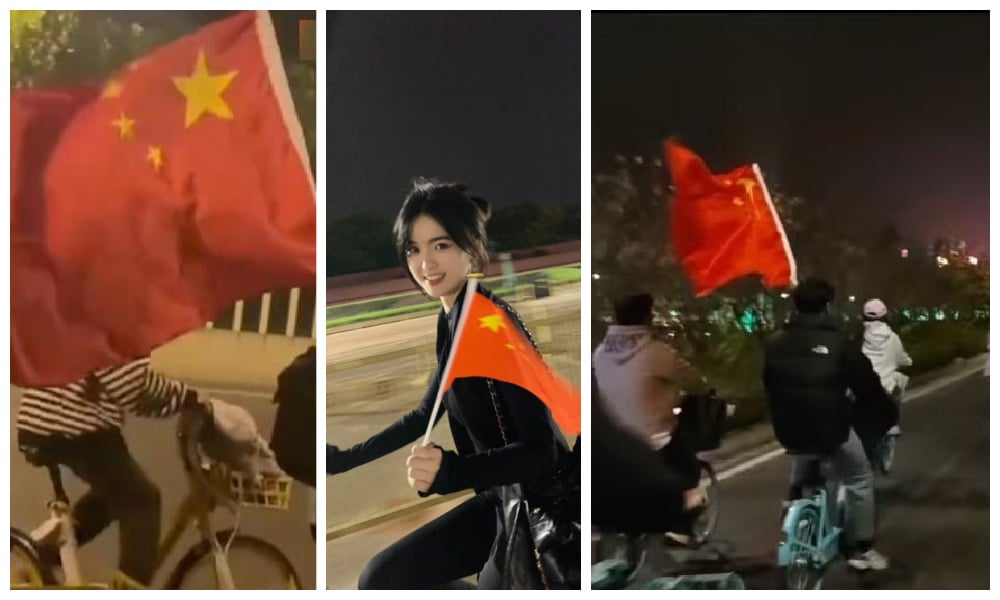
Night riding while waving the national flag.
While some foreign media speculated that the movement carried political undertones, citing at least one flag on the road advocating for the reunification of Taiwan with the motherland, it was likely more about patriotic youth waving non-controversial flags while channeling some nationalistic energy.
It was about “passion”—an English word that became synonymous with the nightly bike ride. It wasn’t about the soup dumplings or the exercise; it was about joy, freedom, and the pure, youthful energy of passion—an important theme for China’s Generation Z, the post-95 and post-00 generations, who often feel pushed and sometimes even paralyzed by the intense social pressures they face.
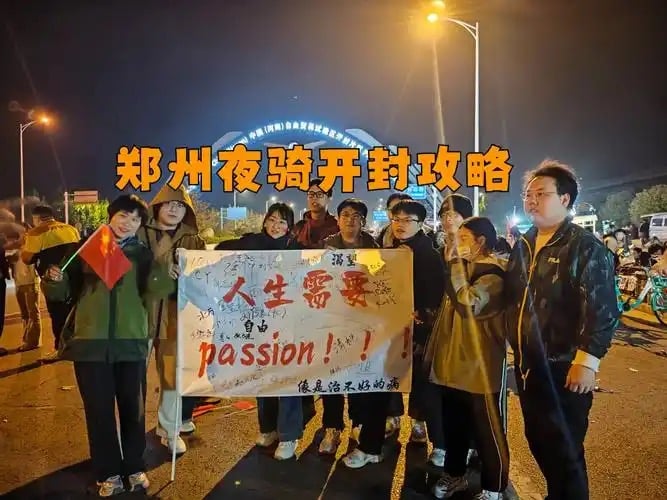
Night riders posing with a poster saying : You need passion in your life (source).
The trend was supported (or facilitated?) by Kaifeng authorities. On November 3, they set up shared bike stations along Zhengkai Avenue to manage the influx of cyclists. Police provided guidance at the scene and ensured safety throughout the night. Kaifeng’s Tourism Bureau issued a “cycling safety advisory” via its official WeChat account, encouraging visitors to adhere to traffic rules, travel sustainably, avoid peak times, and “enjoy the seasonal beauty of Kaifeng with a positive attitude.”
Starting on November 3, Kaifeng’s main tourist attractions, such as Millennium City Park, Wansui Mountain, and Daxiangguo Temple were specially opened to the ‘night riders’ in the middle of the night, even offering them free annual tourism passes (#开封多个景点为夜骑大学生免费#). At this time, the slogan “Youth is priceless, seize the night ride to Kaifeng” (“青春没有售价,夜骑开封拿下”) was actively promoted at Kaifeng tourist spots and in the media.
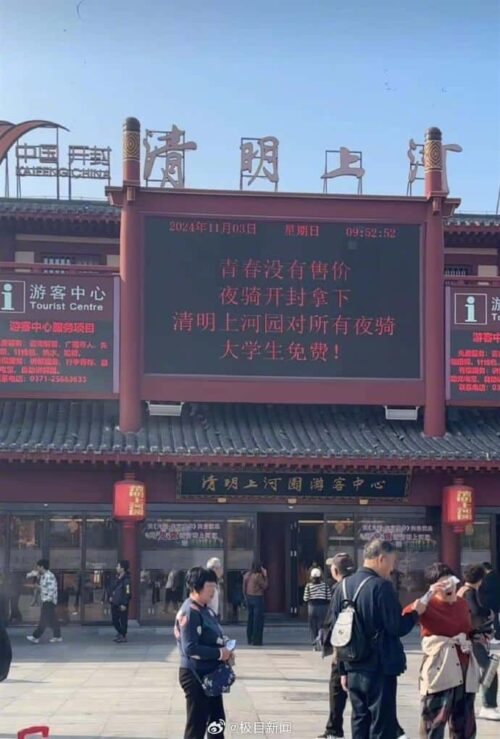
Historical cultural theme park Millennium City Park in Kaifeng on November 3, promoting free access to night riders and the slogan “Youth is priceless, seize the night ride to Kaifeng.”
The shuttle bus taking students back to Zhengzhou was provided for free.
On social apps like Xiaohongshu, students shared various ‘strategy guides’ for the best way to navigate the nightly ride to Kaifeng, including tips such as:
- Choose a comfortable shared bike and avoid unlocking it along the way. With a bike like HelloBike, the journey will only cost 19.5 RMB ($2.70). Starting from Zhengzhou Sports Center Station, head north on Jinshui Road and cycle east in a straight line to Kaifeng. The trip should take about 4 hours.
- From Zhengzhou University to Kaifeng Gulou, the total distance is 79.4 km, with an estimated travel time of 6 hours and 38 minutes. Including breaks and meal stops, the journey could take at least 8 hours.
- Bring a small flag for photo opportunities.
- Upon arrival, visit the Haidilao hotpot restaurant, where they provide blankets and snacks.
- Must-try local dishes: soup dumplings, egg casserole, and deep-fried dough with soy milk.
GOING DOWNHILL
During the weekend of November 8-9, numerous videos emerged showing thousands of students cycling from Zhengzhou to Kaifeng, revealing chaotic scenes (link, link). Some estimates suggested that over 30,000 students had arrived in Kaifeng in a single night.
The trend had a significant impact, raising several concerns. Safety issues loomed large as the sheer number of bicycles on the road created risks, especially given that many participants lacked experience with long-distance cycling. Traffic congestion reached such levels that some cars became trapped amid the cycling groups.

The shared bike system also faced severe challenges. While students eagerly undertook the 4-5 hour downhill journey to Kaifeng, they were unwilling to make the uphill return to Zhengzhou. This resulted in thousands of bikes being abandoned in Kaifeng or along the route, requiring retrieval by the bike companies.
Beyond logistical strain on the bike-sharing system, the abandoned bikes caused significant disruptions in Kaifeng, with entire roads blocked. In Zhengzhou, locals complained about a lack of available bikes for their commutes.
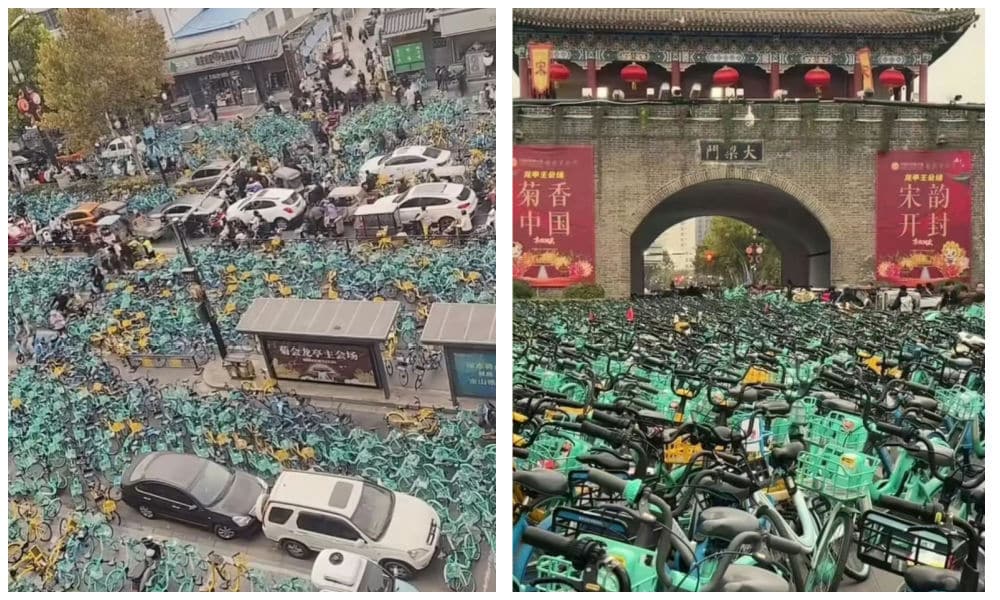
Shared bike chaos in Kaifeng.
While some praised the students’ adventurous spirit, others grew increasingly frustrated with the mounting problems.
By the afternoon of November 9, the official narrative shifted.
Initially, Chinese media celebrated the trend, but reports soon focused on its downsides. One widely shared story featured a 34-year-old man who had joined the ride with his daughter. Unaccustomed to cycling, he became exhausted after only 12-13 kilometers (about 8 miles) (#郑州34岁男子跟风夜骑开封后住院#). He was later hospitalized and diagnosed with hypokalemia (low potassium levels). The message? “Don’t blindly follow the trend.”
Authorities quickly stepped in to stop the night rides. Traffic police in Zhengzhou and Kaifeng issued a joint announcement banning the use of bike lanes on Zhengkai Avenue from 16:00 on November 9 to 12:00 on November 10.
Three major shared bike companies—Meituan, HelloBike, and Qingju—released statements reminding users that their bikes were not intended for cross-city travel. Bikes taken beyond designated zones would automatically lock and incur ‘relocation fees.’
Several universities implemented strict measures, ordering students back to campus and enforcing lockdowns. By Sunday night, some students took to Weibo to report that they were still not allowed to leave their campuses.
THE ROAD AHEAD
Despite the official crackdown on night rides to Kaifeng, some Zhengzhou students have now shifted to walking the entire route, a journey that can take up to 11 hours—equating to 70,000-100,000 steps on a smartwatch pedometer.
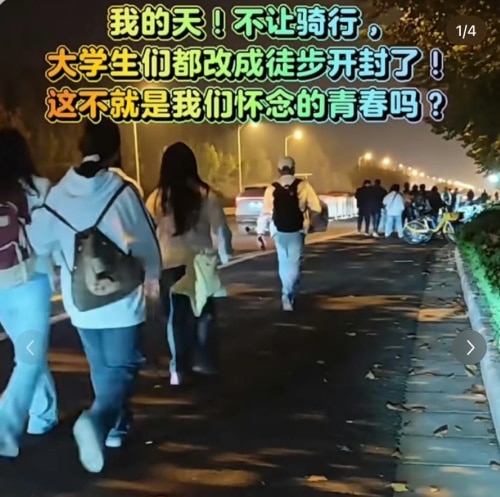
Unable to cycle, groups of students decided to walk to Kaifeng.
The crackdown on the nightly cycling craze has also prompted some reflection.
While many netizens praise the students for “truly embodying youth and vitality,” others see a deeper significance in the trend.
On Weibo, author Xu Kaizhen (许开祯) offers his perspective on what the Kaifeng phenomenon reveals about Chinese youth today. He writes:
“On the surface, the Kaifeng craze appears to be the latest trend in cultural tourism. But at its core, it has nothing to do with tourism. What is it really about? It’s about young people, about youth. And it’s not about youthful rebellion or hormones—modern youth have moved beyond that. It’s about escape. A collective, grand escape. An escape from a mediocre era, a mediocre life, and even a mediocre background. Every young person who joined the night ride was driven by a need to escape. Dissatisfied with reality yet powerless to change it, they turned to this collective unconscious act of performance art.”
Despite the criticism, it seems many hold a soft spot for China’s youth, understanding the challenges they face. As one popular comment puts it: “I dearly love this generation of Chinese youth. Their daytime has been drained by the previous generation, leaving only the night for them to carve out some space to unwind. ‘Escape’ describes it perfectly.”
For now, it seems the Kaifeng trend isn’t over. What began as an innocent, fun-loving initiative has turned into a mass mobilization that raises questions about hyped-up tourism, city marketing, and, most importantly, the boundless energy of China’s new generation. While the phenomenon has left many puzzled, some argue it’s crucial to grasp the youth’s yearning for these kinds of adventures.
As Xu Kaizhen concluded: “Perhaps by understanding this night ride, we can truly understand this generation. No—perhaps we can begin to understand the coming era.”
See our X thread with videos on this trend.
By Manya Koetse, with contributions by Miranda Barnes
(follow on X, LinkedIn, or Instagram)
Spotted a mistake or want to add something? Please let us know in comments below or email us. First-time commenters, please be patient – we will have to manually approve your comment before it appears.
©2024 Whatsonweibo. All rights reserved. Do not reproduce our content without permission – you can contact us at info@whatsonweibo.com.
Subscribe

Inside the Labubu Craze and the Globalization of Chinese Designer Toys

Lured with “Free Trip”: 8 Taiwanese Tourists Trafficked to Myanmar Scam Centers

10 Viral Chinese Phrases You Didn’t Know Came From Video Games

Earring Gate: Huang Yangdiantian and the 2.3 Million RMB Emerald Earrings

Guming’s 1 Yuan Ice Water: China’s Coolest Summer Trend

China Is Not Censoring Its Social Media to Please the West

IShowSpeed in China: Streaming China’s Stories Well

China Reacts: 3 Trending Hashtags Shaping the Tariff War Narrative

US-Russia Rapprochement and “Saint Zelensky”: Chinese Online Reactions to Trump’s Shake-Up

Chinese New Nickname for Trump Mixes Fairy Tales with Tariff War

Squat or Sit? China’s Great Toilet Debate and the Problem of Footprints on the Seat

China Trending Week 15/16: Gu Ming Viral Collab, Maozi & Meigui Fallout, Datong Post-Engagement Rape Case

Strange Encounter During IShowSpeed’s Chengdu Livestream

No Quiet Qingming: From High-Tech Tomb-Sweeping to IShowSpeed & the Seven China Streams

From Trade Crisis to Patriotic Push: Chinese Online Reactions to Trump’s Tariffs
Get in touch
Would you like to become a contributor, or do you have any tips or suggestions? Get in touch here!
Popular Reads
-

 China Media11 months ago
China Media11 months agoA Triumph for “Comrade Trump”: Chinese Social Media Reactions to Trump Rally Shooting
-

 China Society8 months ago
China Society8 months agoDeath of Chinese Female Motorcycle Influencer ‘Shigao ProMax’ Sparks Debate on Risky Rides for Online Attention
-

 China Memes & Viral11 months ago
China Memes & Viral11 months agoThe “City bu City” (City不City) Meme Takes Chinese Internet by Storm
-

 China Society11 months ago
China Society11 months agoHero or Zero? China’s Controversial Math Genius Jiang Ping








Cynthia Santovena
June 15, 2019 at 8:15 am
WTH!!! 12 beautiful living horses were slaughtered so they can be taxidermied and stuffed. This is wrong on all levels and should be an international outrage. Horses and all equines deserve our love and respect. They are such beautiful and majestic creatures… Who is the demon responsible for this evil act?
Rebecca Paquette
September 30, 2020 at 10:15 pm
I don’t know what disgusts me more: the inhumane show case stalls or the horses killed and stuffed for display pieces. Whoever is in charge of this entire clusterflock should be jailed. I need to go be sick now.